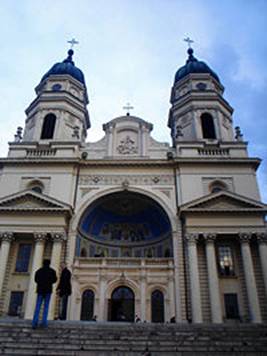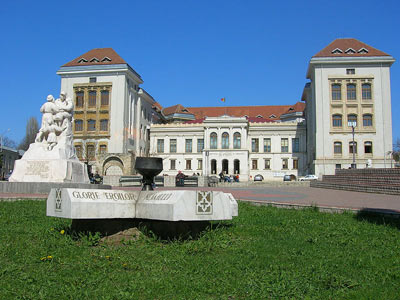Iasi
Iaşi is a city and municipality in north-eastern Romania. The city was the capital of Moldavia from the 16th century until 1861 and of Romania (Romanian Kingdom) between 1916–1918 during World War I.
The second largest Romanian city, Iaşi is the economic, cultural and academic centre of the Romanian region of Moldavia. The city has the oldest Romanian university and accommodates an annual count of over 60,000 students in 5 public and 3 private universities. It is home to more than 50 churches and hosts 5 cultural centers: British, French, German, Latin American & Caribbean and Hellenic. Cultural life gravitates around the National Theater (the oldest in Romania), the Opera House, the Iaşi State Philarmonic, the Tătăraşi Atheneum, a famous Botanical Garden (the oldest and largest in Romania), the Central University Library (the oldest in Romania), an array of museums and memorial houses, an independent theater and several student organizations.
Etymology
The city is historically referred to as Jassy; (Hungarian: Jászvásár, Greek: Ιάσιο, Romany: Yashi; Yiddish: יאס Yas).
Scholars have different theories on the origin of the name "Iaşi". Some argue that the name originates with the Sarmatian tribe Jazyges (of Iranian origin), one mentioned by Ovid as "Ipse vides onerata ferox ut ducata Iasyx/ Per media Istri plaustra bubulcus aquas" and "Jazyges et Colchi Metereaque turba Getaque/ Danubii mediis vix prohibentur aquis".
A nowadays lost inscription on a Roman milestone[2] found near Osijek, Croatia by Matija Petar Katančić in the 18th century, mentions the existence of a Jassiorum municipium.[3]
Another explanation is that the name originated from the Iranian Alanic tribe of Jassi. The Hungarian name of the city (Jászvásár) literally means "Jassic Market"; the antiquated Romanian name, Târgul Ieşilor (and the once-favoured Iaşii), may indicate the same meaning.
The city is first mentioned in a 1408 document by Moldavian Prince (Voivode) Alexandru cel Bun. However, as buildings older than 1408 existed and still exist (for example the Armenian Church originally believed to be built in 1395; the present building is from the modern era), it is believed that the city existed long before its first mentioning.
History
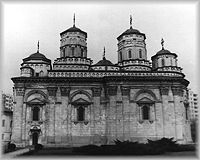
The Metropolitan Cathedral of Moldavia and Bukovina
Around 1564, Prince Alexandru Lăpuşneanu moved the Moldavian capital from Suceava to Iaşi. Between 1561 and 1563, a school and a Lutheran church were founded by the Greek adventurer Prince, Ioan Iacob Heraclid. In 1640, Vasile Lupu established the first school in which the mother-tongue replaced Greek, and set up a printing press in the Byzantine Trei Ierarhi Church (Church of the Three Hierarchs; built 1635–39). In 1643, the first volume ever printed in Moldavia was issued in Iaşi.
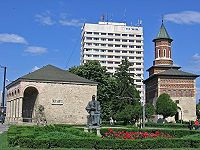
Dosoftei House and the "Domnească" church in the Civic Centre
The city was burned down by the Tatars in 1513, by the Ottomans in 1538, by the Imperial Russian troops in 1686. In 1734, it was hit by the plague.
Through the Peace of Iaşi, the sixth Russo-Turkish War was brought to a close in 1792. A Greek revolutionary maneuver and occupation under Alexander Ypsilanti (Αλέξανδρος Υψηλάντης) and the Filiki Eteria (Φιλική Εταιρία) (1821, at the beginning of the Greek War of Independence) led to the storming of the city by the Turks in 1822. In 1844 there was a severe conflagration.
Between 1565 and 1859, the city was the capital of Moldavia; then, between 1859 and 1862, both Iaşi and Bucharest were de-facto capitals of the United Principalities of Moldavia and Wallachia (the Danubian Principalities). In 1862, when the union of the two principalities was recognized under the name of Romania, the national capital was established in Bucharest. For the loss caused to the city in 1861 by the removal of the seat of government to Bucharest the constituent assembly voted 148,150 lei to be paid in ten annual installments, but no payment was ever made.
Iaşi's primitive houses of timber and plaster were mostly swept away after 1860, when brick or stone came into general use, and better streets were cut through the network of narrow, unsanitary lanes.
During World War I, Iaşi was the capital of a severely reduced Romania for two years, following the Central Powers' occupation of Bucharest on December 6, 1916. The capital was returned to Bucharest after the defeat of Imperial Germany and its allies in November 1918.
In May 1944, Iaşi became the scene of ferocious fighting between Romanian-German forces and the advancing Soviet Red Army and the city was partially destroyed. The elite German Panzergrenadier Division Großdeutschland won an impressive defensive victory at the Battle of Târgul Frumos, a location near Iaşi. The battle was the object of several NATO studies during the Cold War. By July, Iaşi had been taken by Soviet forces.
Geography
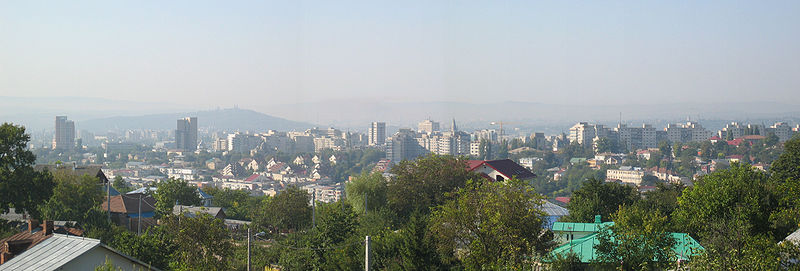
Panoramic view over Iaşi
The city of Iaşi lies on the Bahlui River, a tributary of the Jijia (tributary of the Prut). The surrounding country is one of uplands and woods, featuring the monasteries of Cetăţuia, Frumoasa, Galata (with nearby mineral springs), and the dendrologic park of Repedea. Iaşi itself stands amid vineyards and gardens, partly on two hills, partly in the in-between valley. It is a common belief that Iaşi is built on seven hills (coline in Romanian): Cetăţuia, Galata, Copou-Aurora, Bucium-Păun, Şorogari, Repedea and Breazu, thus triggering comparisons with Rome, la città dei sette colli (The city of the seven hills). The city is about to become a metropolitan area, expanding its territory with 10 other communities surrounding the city.
Population
1859: 50,000
1900: 78,000 (the second-largest city in Romania)
1930: 102,872
1948: 96,075
1966: 161,023
1977: 265,002
1992: 344,425 (the third-largest city)
2002: 320,888 (the second-largest city)
2004: 317,812 (as of July 1st, 2004, the second-largest city)[6]
2006: 306,000 (the third-largest city)[7]
2007 (July 1st): 315,214 (second largest city)[8]
Main sights
Iaşi is an outstanding educational center, and preserves some beautiful pieces of architecture, such as the Trei Ierarhi Church and the neo-Gothic Palace of Culture (the site of four museums - of History, of Technology, of Ethnography, and of Art). Many buildings in the old city center were demolished during the Communist regime, with a few Soviet-style blocks of flats built instead.
Churches
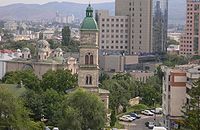
Bărboi Church, View from Golia Tower
Iaşi (specifically the Metropolitan Cathedral) is the seat of the Romanian Orthodox Metropolitan of Moldavia, and of the Roman Catholic Bishop of Iaşi. There are currently almost 10,000 Roman Catholics living in Iaşi.[9] There is a debate between historians as to whether or not the Catholics are originally of Romanian or Hungarian descent.[10] The city houses more than 40 churches. The oldest one is Saint Nicholas, dating from the reign of Stephen the Great (1457–1504); perhaps the finest, however, are the 17th century older metropolitan church, Saint Spiridion and Trei Ierarhi, the last a curious example of Byzantine art, erected in 1635–1639 by Vasile Lupu, and adorned with countless gilded carvings on its outer walls and twin towers. Other beautiful churches, some surrounded by big walls, are: Galata (1581), Golia, St. Sava, Barnovschi (17th century), Cetăţuia (the end of the 17th century), Frumoasa (18th century), Bărboi (19th century, with 18th century bell tower).
Gardens and parks
Cultural life
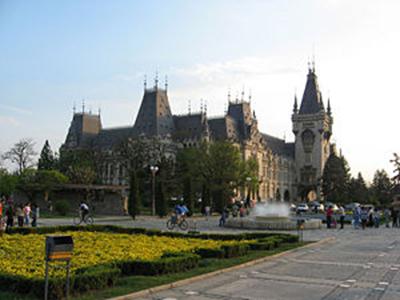
The Palace of Culture
One of the most important cultural center, Iaşi has many theaters, museums, and the like.
The "Vasile Alecsandri" National Theater, opened in 1837 is the oldest National Theatre in Romania. The building, designed according to the plans of the Viennese architects Hermann Helmer and Ferdinand Fellner was built between 1894–1896, and also hosts starting 1956 the National Romanian Opera Iaşi.
Iasi is home to
Iaşi State Philarmonic
"Luceafărul" Theater for children and youth
Tătăraşi Atheneum
Four museums are located in the Palace of Culture, one of the largest buildings of Romania. Construction was carried out between the years 1906–1925 on the old ruins of the Royal Court of Moldavia and it is designed in flamboyant neo-Gothic style. The palace counts 298 rooms and has a total room surface of about 36 000 m².
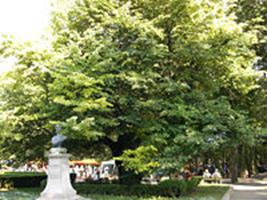
Eminescu's linden tree in Copou Park

National Theatre Vasile Alecsandri
The Art Museum has the largest art collection in Romania, with more than 8,000 paintings, out of which 1,000 belong to the national and universal patrimony
The Moldavian History Museum offers more than 35,000 objects from various fields: archaeology, numismatics, decorative art, ancient books, documents
The Ethnographic Museum of Moldavia owns more than 11,000 objects depicting the Romanian advance through the ages
The Museum of Science and Technology offers many musical devices
Foreign culture centres
French Cultural Centre
German Cultural Centre
British Cultural Centre
Latin American and Caribbean Cultural Centre
Hellenic Cultural Centre
Economy
Iasi is an important economic centre in Romania. It has an active trade in metals, medical drugs (antibiotics), textiles and clothing, banking, wine, preserved meat. The city has also become an important IT sector centre, with many software companies and two universities that provide high quality graduate engineers. Iasi is also an important regional commercial centre.
Education and science
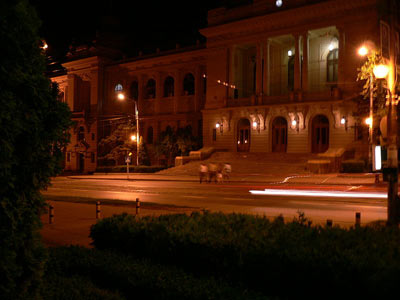
Gr. T. Popa University of Medicine and Pharmacy Iasi, sector A.
A society of physicians and natural historians has existed in Iaşi since the early part of the 19th century, and a number of periodicals are published. One of the oldest medical universities in Romania, founded in 1879, is in Iaşi. It is now known as the "Grigore T. Popa" University of Medicine and Pharmacy.
The first Technical High Education structure in Romanian language was established in the autumn of 1813, when engineer Gheorghe Asachi laid the foundations of a class of engineers, its activities taking place within the Greek Academy of Iaşi.
After 1813, other moments marked the development of higher education in Romanian, regarding both humanities and the technical science. In 1835, Academia Mihăileană was founded in Iaşi by Prince Mihail Sturdza.
Iaşi is home to the oldest Romanian university (University of Iaşi), opened by (and nowadays named after) Domnitor Alexandru Ioan Cuza in 1860. The city is host to five universities, and is widely regarded as the cultural "heart" of the Old Kingdom (that is Moldavia, Wallachia, and Dobruja - the three regions comprising Romania until 1918).
In 1937, the two applied science sections of the university of Iaşi became departments of the newly created Gheorghe Asachi Polytechnic School; In the period before and after World War II, the later (renamed Polytechnic Institute in 1948) extended its domain of activity, especially in the field of engineering, and became adopted a Technical University in 1993.
Public Universities:
"Al. I. Cuza" University
"Gh. Asachi" Technical University
"Gr. T. Popa" University of Medicine and Pharmacy
"G. Enescu" University of Arts
"I. Ionescu de la Brad" University of Agricultural Sciences and Veterinary Medicine
Besides the universities, there are schools of art and music. The University's Central Library, where the chief records of Romanian history are preserved, is the oldest and the second largest in Romania.

